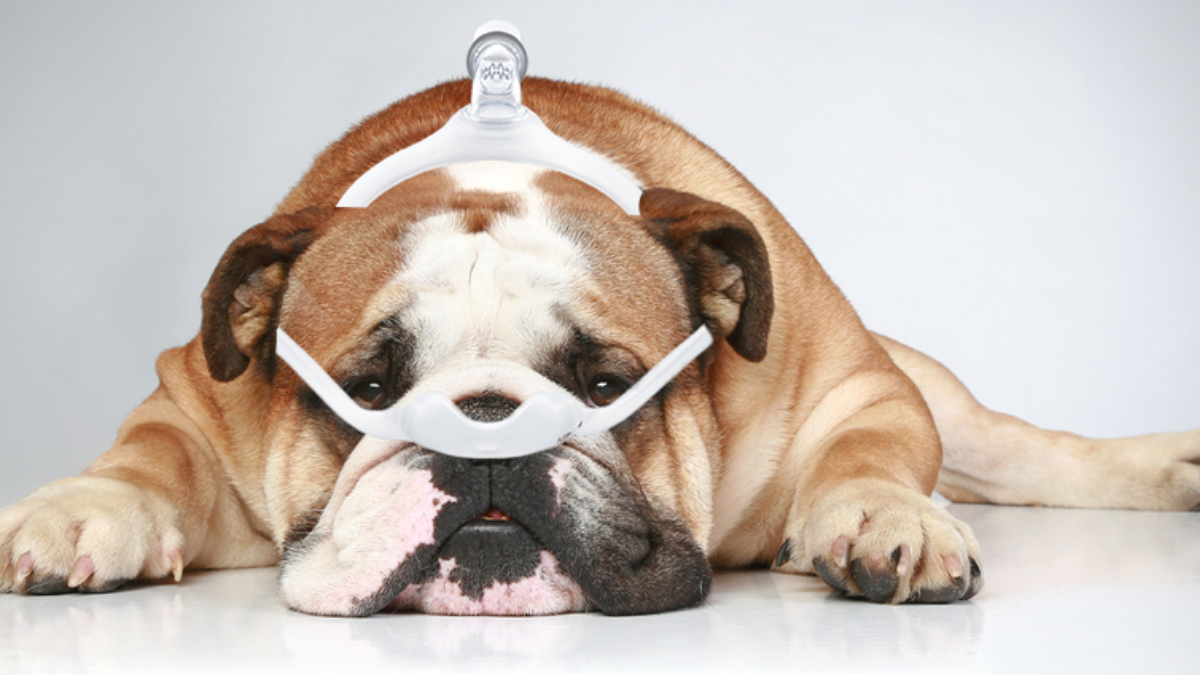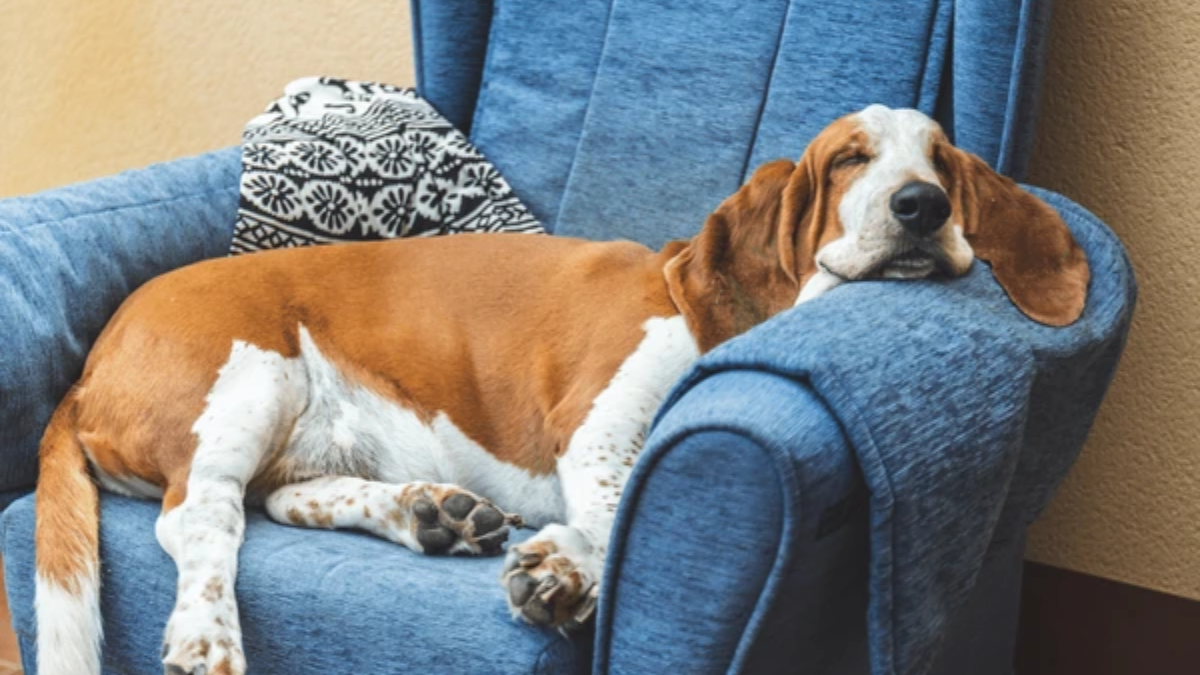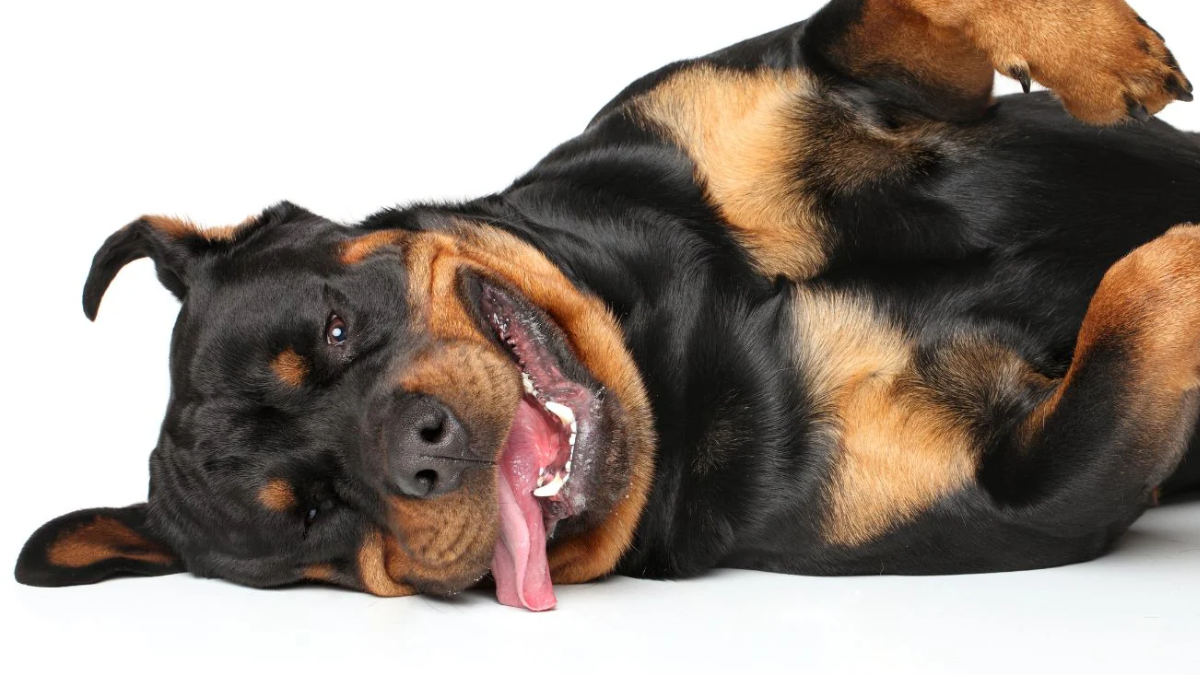Canine Sleep apnea is a common condition among humans, but did you know that dogs can also suffer from it? Canine sleep apnea is a disorder that causes a dog to stop breathing while sleeping. This condition can lead to serious health problems if left untreated, so dog owners need to be aware of the signs and risks associated with it.
One of the most common signs of canine sleep apnea is loud snoring. While some dogs may snore occasionally, persistent and loud snoring can be a sign of a more serious problem. Other signs to look out for include gasping or choking sounds, restlessness during sleep, and excessive daytime sleepiness. If you notice any of these symptoms in your dog, it's important to consult a veterinarian to determine the underlying cause and appropriate treatment options.

Embark on an extraordinary journey in pet care with Fi's revolutionary collar technology, setting new standards in innovation. Seamlessly monitor your dog's sleep patterns, placing their health and happiness at the forefront of your priorities. Click now to completely revolutionize your furry friend's sleep quality, paving the way for a brighter and more fulfilling life! Immerse yourself in the dynamic and vibrant world of pet care and technology with Fi Collar – Join our ever-growing community today and be part of the next wave of pet care innovation!
Understanding Canine Sleep Apnea
Defining Sleep Apnea in Dogs
Sleep apnea is a sleep disorder that affects dogs as well as humans. It is characterized by pauses in breathing during sleep, which can last for a few seconds or even minutes. These pauses can occur multiple times throughout the night, causing disruptions in sleep patterns and leading to a range of health problems.
In dogs, sleep apnea can be caused by a variety of factors, including obesity, allergies, and anatomical abnormalities. Some dogs may also have a genetic predisposition to the condition.
Prevalence and At-Risk Breeds
While sleep apnea can affect any breed of dog, some breeds are more at risk than others. Brachycephalic breeds, such as pugs, bulldogs, and boxers, are particularly prone to developing sleep apnea due to their short snouts and narrow airways.
Other breeds that may be at increased risk include:
- Dachshunds
- Basset Hounds
- Shar Pei
- Rottweilers
It's important for dog owners to be aware of the signs of sleep apnea and to seek veterinary care if they suspect their pet may be affected. Early diagnosis and treatment can help to improve the quality of life for dogs with this condition.
Recognizing the Signs of Sleep Apnea
Sleep apnea is a common condition that affects dogs of all breeds and ages. It is a serious condition that can have a significant impact on a dog's health and well-being. Fortunately, recognizing the signs of sleep apnea can help you get your dog the treatment they need.

Common Symptoms
The most common symptom of sleep apnea in dogs is loud, persistent snoring. This snoring is often accompanied by pauses in breathing, gasping, or choking sounds. Dogs with sleep apnea may also exhibit restless sleep, waking up frequently during the night, and excessive daytime sleepiness.
Behavioral Indicators
Dogs with sleep apnea may exhibit a range of behavioral indicators that can help you identify the condition. For example, they may be more irritable or aggressive than usual, especially when they are tired. They may also be less active and less interested in playing or going for walks.
Other behavioral indicators of sleep apnea in dogs include:
- Difficulty staying asleep
- Difficulty getting up in the morning
- Lack of energy or enthusiasm
- Difficulty concentrating or paying attention
- Increased appetite or weight gain
If you notice any of these symptoms or behavioral indicators in your dog, it is important to seek veterinary care right away. Sleep apnea can have serious health consequences if left untreated, so it is important to get your dog the treatment they need as soon as possible.
Potential Risks and Complications
Health Consequences
Canine sleep apnea can lead to several health consequences if left untreated. The most immediate risk is a lack of oxygen, which can cause the dog to wake up gasping for air or even collapse. This can be especially dangerous for dogs with pre-existing heart or lung conditions, as it can put additional strain on these organs.

Over time, the lack of quality sleep can also affect a dog's overall health and well-being. Dogs with sleep apnea may become more irritable or lethargic, and they may have difficulty concentrating or learning new commands. This can make it difficult for them to bond with their owners or perform their duties as service animals.
Long-Term Effects
If left untreated, canine sleep apnea can have more serious long-term effects. Chronic oxygen deprivation can lead to a range of health problems, including high blood pressure, heart disease, and stroke. It can also weaken the immune system, making the dog more susceptible to infections and illnesses.
In addition, sleep apnea can exacerbate pre-existing conditions, such as obesity or arthritis. Dogs with sleep apnea may have difficulty maintaining a healthy weight or getting enough exercise, which can further complicate these conditions.
Overall, it is important for dog owners to be aware of the potential risks and complications of sleep apnea and to seek treatment if their dog is exhibiting any symptoms. With proper care and management, most dogs with sleep apnea can live happy, healthy lives.
Diagnostic Procedures
Veterinary Examination
If a dog is suspected of having sleep apnea, the first step is to take them to a veterinarian. The vet will perform a physical examination, which may include listening to the dog's breathing, checking their heart rate, and assessing their overall health. The vet may also ask the dog's owner about their symptoms and sleeping patterns.
During the examination, the veterinarian may also check for any underlying conditions that could be contributing to the dog's sleep apnea, such as obesity, allergies, or respiratory infections. If necessary, the vet may refer the dog to a specialist for further testing.
Sleep Studies and Tests
In some cases, a veterinarian may recommend that a dog undergo a sleep study or other diagnostic tests to confirm a diagnosis of sleep apnea. Sleep studies involve monitoring the dog's breathing and other vital signs while they sleep. This can be done either at a veterinary hospital or at home using special equipment.

Other diagnostic tests that may be performed include blood tests, X-rays, and CT scans. These tests can help identify any underlying conditions that could be contributing to the dog's sleep apnea, such as a nasal obstruction or enlarged tonsils.
Overall, a thorough veterinary examination and diagnostic testing are essential for accurately diagnosing and treating canine sleep apnea. With proper diagnosis and treatment, many dogs with sleep apnea can experience significant improvement in their symptoms and overall quality of life.
Treatment Options
Medical Interventions
When it comes to treating canine sleep apnea, medical interventions may be necessary in certain cases. For example, if the underlying cause of the condition is a physical obstruction in the airway, surgery may be required to correct the issue. Additionally, if the sleep apnea is caused by an underlying medical condition, such as hypothyroidism or heart disease, treating that condition may help alleviate the symptoms of sleep apnea.
In some cases, medication may also be prescribed to help manage the symptoms of sleep apnea. For example, sedatives or muscle relaxants may be used to help keep the airway open during sleep.
Lifestyle and Home Care
In addition to medical interventions, there are also lifestyle changes and home care practices that can help manage the symptoms of canine sleep apnea. For example, maintaining a healthy weight can help reduce the risk of sleep apnea, as excess weight can put pressure on the airway and make breathing more difficult.
Additionally, providing a comfortable sleeping environment for your dog can help promote better sleep and reduce the risk of sleep apnea. This may include providing a comfortable bed and ensuring that the sleeping area is quiet and free from distractions.
Finally, it is important to work with your veterinarian to develop a comprehensive treatment plan that takes into account your dog's individual needs and medical history. By working together, you can help ensure that your dog receives the best possible care and management for their sleep apnea.
Prevention Strategies
Several prevention strategies can help reduce the risk of canine sleep apnea. These include weight management and environmental factors.
Weight Management
Obesity is a major risk factor for sleep apnea in dogs. Therefore, maintaining a healthy weight is crucial in preventing the condition. A balanced diet and regular exercise can help dogs maintain a healthy weight. It is important to consult with a veterinarian to determine the appropriate diet and exercise plan for each dog.

Environmental Factors
Environmental factors can also contribute to sleep apnea in dogs. Smoking, second-hand smoke, and exposure to air pollution can all increase the risk of sleep apnea. Therefore, it is important to keep the dog's environment clean and free of smoke and other pollutants. Additionally, keeping the dog's sleeping area clean and well-ventilated can also help reduce the risk of sleep apnea.
Overall, by implementing these prevention strategies, pet owners can help reduce the risk of canine sleep apnea and improve their dog's overall health and well-being.
When to Consult a Veterinarian
If a dog is suspected of having sleep apnea, it is important to consult a veterinarian. A veterinarian can perform a thorough physical examination of the dog and evaluate its medical history to determine if the dog has sleep apnea.
During the examination, the veterinarian may ask questions about the dog's sleeping habits and may observe the dog while it sleeps. The veterinarian may also perform diagnostic tests, such as a sleep study, to confirm the diagnosis of sleep apnea.
If a dog is diagnosed with sleep apnea, the veterinarian may recommend treatment options such as weight loss, changes in sleeping position, or the use of a continuous positive airway pressure (CPAP) machine. In some cases, surgery may be necessary to correct the underlying cause of the sleep apnea.
It is important to seek veterinary care as soon as possible if a dog is suspected of having sleep apnea. Sleep apnea can lead to serious health complications if left untreated, including heart disease, high blood pressure, and stroke. By working closely with a veterinarian, dog owners can help ensure that their pets receive the appropriate treatment and care for sleep apnea.

Case Studies and Research Findings
Several case studies and research findings have shown that sleep apnea in dogs is a significant problem that can lead to severe health issues if left untreated. One study conducted by the University of Pennsylvania School of Veterinary Medicine found that 23% of dogs referred for evaluation of snoring and other respiratory issues had sleep apnea.
In another study published in the Journal of Veterinary Internal Medicine, researchers found that brachycephalic breeds, such as bulldogs and pugs, were at a higher risk of developing sleep apnea due to their narrowed airways. The study also found that overweight dogs were more likely to develop sleep apnea.
Treatment options for canine sleep apnea vary depending on the severity of the condition. Mild cases may be treated with weight loss and lifestyle changes, while more severe cases may require surgery or the use of a continuous positive airway pressure (CPAP) machine.
Dog owners need to be aware of the signs of sleep apnea, which include loud snoring, gasping or choking during sleep, and excessive daytime sleepiness. If a dog is exhibiting these symptoms, it is important to consult with a veterinarian to determine the best course of treatment.
Conclusion:
In conclusion, addressing Canine Sleep Apnea is crucial for maintaining your dog's overall health and well-being. By recognizing the symptoms, seeking timely diagnosis, and exploring appropriate treatment options, you can effectively manage this condition and improve your pet's quality of life. Remember to consult with a veterinarian for personalized guidance tailored to your dog's specific needs. Implementing lifestyle adjustments, such as providing a comfortable sleeping environment and monitoring your dog's weight, can complement medical interventions and contribute to better outcomes.
Stay vigilant for any changes in your dog's breathing patterns or behavior, as early detection and intervention are key to managing Canine Sleep Apnea successfully. Additionally, educating yourself about this condition and staying informed about the latest advancements in treatment can empower you to make informed decisions and advocate for your pet's health. Together with your veterinarian, you can work towards minimizing the impact of Canine Sleep Apnea on your dog's life, ensuring they can enjoy restful sleep and thrive for years to come.




